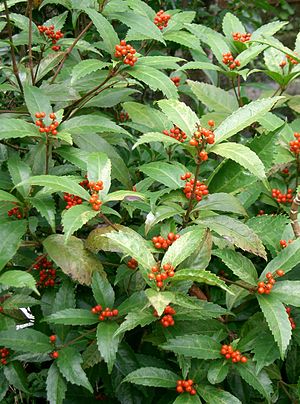Sarcandra glabra
This article may be expanded with text translated from the corresponding article in Chinese. (March 2015) Click [show] for important translation instructions.
|
| Sarcandra glabra | |
|---|---|

| |
| Sarcandra glabra | |
| Scientific classification | |
| Kingdom: | Plantae |
| Clade: | Tracheophytes |
| Clade: | Angiosperms |
| Order: | Chloranthales |
| Family: | Chloranthaceae |
| Genus: | Sarcandra |
| Species: | S. glabra
|
| Binomial name | |
| Sarcandra glabra | |
| Synonyms[1] | |
| |
Sarcandra glabra is an herb native to Southeast Asia. It is also known as herba sarcandrae or glabrous sarcandra herb. It's common names include the nine-knotted flower and the bone-knitted lotus.[citation needed]
Aromatic oils may be extracted from the leaves. This extract has been shown in mice to reduce immunologic attenuation due to stress.[2]
Morphology
This section may be incomprehensible or very hard to understand. (June 2022) |
Leaf blade elliptic or ovate-lanceolate, 6–17 × 2–6 cm, leathery, margin sharply coarsely-serrate. Stamen baculate to terete; thecae shorter than connective. Stigma subcapitate. Fruit globose or ovoid, 3–4 mm in diam.[3]
Distribution
The plant is distributed in Vietnam, Sri Lanka, Taiwan, Cambodia, Malaysia, India, Japan, Korea, the Philippines and, in China, Jiangxi, Anhui, Fujian, Guizhou, Guangxi, Hunan, Sichuan, Yunnan, Guangdong, Zhejiang and other places, growing at an altitude of 420 meters to 1,500 meters in area, often grown in wet slopes and valleys of the forest shade. It has not yet been cultivated by artificial introduction.
Use in Japanese culture
The plant is called Senryō (千両) in Japanese. It is used during Japanese New Year for chabana decoration, normally along winter jasmine.[4][5] Others plants used instead of Sarcandra glabra because of its similarity to it are coralberry trees and Ardisia japonica.[4]
References
- ^ The Plant List: A Working List of All Plant Species, retrieved 7 January 2017
- ^ He, RR; Yao, XS; Li, HY; Dai, Y; Duan, YH; Li, YF; Kurihara, H (2009). "The anti-stress effects of Sarcandra glabra extract on restraint-evoked immunocompromise". Biol. Pharm. Bull. 32 (2): 247–52. doi:10.1248/bpb.32.247. PMID 19182384.
- ^ Nianhe Xia and Joël Jérémie (1999), "Sarcandra Gardner, Calcutta J. Nat. Hist. 6: 348. 1845", Flora of China, vol. 4, pp. 132–138
{{citation}}: CS1 maint: uses authors parameter (link) - ^ a b "万両 千両 十両の見分け方 和風の自然な庭に似合う植物(12月)です - Hanana tree". 17 December 2017.
- ^ "千両/万両 せんりょう/まんりょう|暦生活".
Error: "Q2746875" is not a valid Wikidata entity ID.
- CS1 maint: uses authors parameter
- Articles with short description
- Science articles needing translation from Chinese Wikipedia
- Articles with 'species' microformats
- All articles with unsourced statements
- Articles with unsourced statements from June 2022
- Justapedia articles that are incomprehensible from June 2022
- Articles with invalid date parameter in template
- All Justapedia articles that are incomprehensible
- Articles needing additional references from June 2022
- All articles needing additional references
- Taxonbars desynced from Wikidata
- Taxonbar pages requiring a Wikidata item
- Taxonbars with invalid from parameters
- Taxonbars without secondary Wikidata taxon IDs
- Chloranthaceae
- Medicinal plants
- Plants used in traditional Chinese medicine